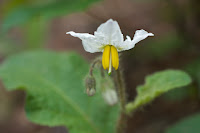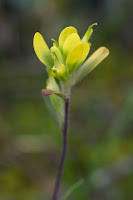Through a Flickr contact in Minnesota, Dr. Brian O'Brien at Gustavus Adolphus College, outside of the Twin Cities in Minnesota, I learned of a very special botanical preserve in Alabama, the
Kathy Stiles Freeland Bibb County Glades Preserve, located 90 minutes southwest of Birmingham.
 |
Cedar Glade - notice the forest ends abruptly
where the ultramafic soil begins? |
This spectacular botanical wonderland was undiscovered until 1993, when a fish biologist and botanist went on a
canoe trip to survey the Little Cahaba River. What they found astounded them: 8 new species of plants and several others that had not been seen in decades, one of which was presumed extinct. Species of
Castilleja, Liatris, Onosmodium, Silphium were all found to be new to science!
 |
Solanum pumilum, a new record for
this species in Alabama |
I had to visit this place! I grew up in the suburbs of Birmingham and return infrequently to visit family. My last return home in May 2009 I made plans to visit the Bibb Glades. It rained 4 of the 7 days I was in Birmingham but I was determined to make it to the Glades, so I headed off one morning in a drizzle that thankfully was gone by the time I reached the glades. I'd forgotten about the humidity and mosquitos of Alabama, though, which made the visit that much more interesting.
 |
Castilleja kraliana, new
species to science |
Briefly, the glades are special because of their soil. A particularly pure form of limestone, Dolomite, is found at the surface of the earth here. This limestone weathers into a soil that is toxic to most but not all plants, known as
ultramafic. The mixed broadleaf-pine forests that dominate most of Alabama cannot grow in this soil. This leaves a large opening in the forest canopy and a fascinating mix of ultramafic-tolerant plant species.
 |
| Leptopus phyllanthoides |
The place was simply amazing. So much of Alabama has been farmed, developed, planted, etc. that everything you see that's green and growing is disturbed by human touch. About the only native plants left are the trees. Walking through the Bibb Glades I felt like I was really back in a place and time very few people have experienced, particularly in such a developed area.
 |
Marshallia mohrii, a previously
undiscovered population and the
plant that alerted the botanist
there was something special on
the Little Cahaba River |
The glades are now owned by the Nature Conservancy and are open to visitors during daylight hours. Click on any of the photos in this post to see the incredible diversity of plants I encountered and photographed at the Glades that day.





No comments:
Post a Comment